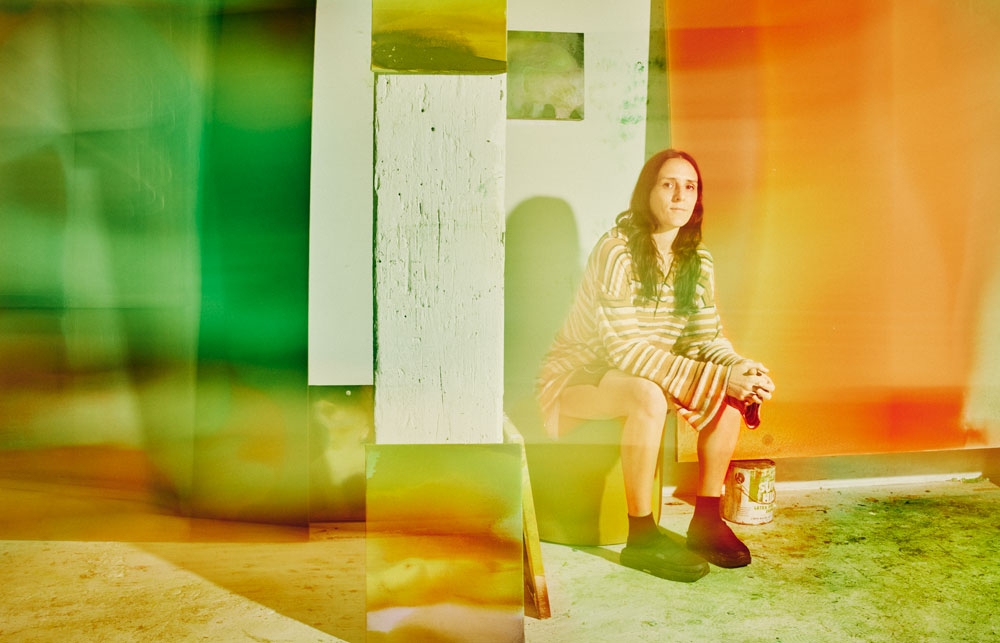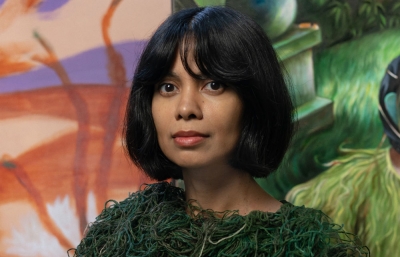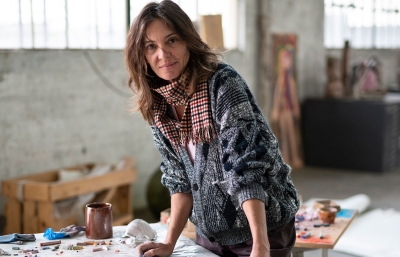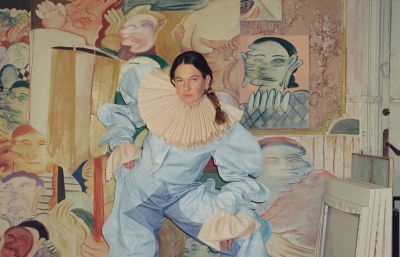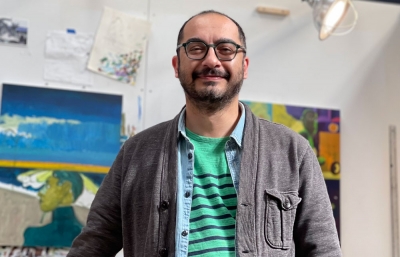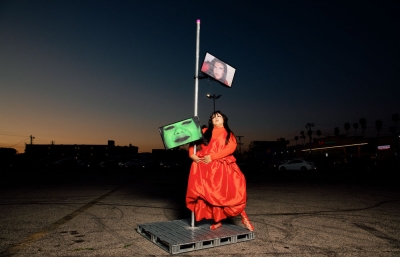Elizabeth Glaessner
The In-Between
Interview by Shaquille Heath // Portrait by Bryan Derballa
There are a lot of things I’ve felt looking at the work of Elizabeth Glaessner, but I’m not sure any of those feelings are correct after spending a morning taking in her every word. When we spoke, she was in France completing the second part of a residency as she tottered around on a small stool while talking me through her color theory and experimenting with scale and the dissonance we all encounter between our bodies and faces. Like a phantom on the terrace of Glaessner’s bookish mind, I came to the realization that the dreamy nature of her artwork is just as mutable as the subjects she's compelled to paint. There’s really not a concrete answer for it all, for the lore and legends she references in conversation that inspire some of her canvases. The best parts live not in the answers but in the existential questions that these kinds of stories bring forth. How they mutate and change upon any day, like the weather or a gust of wind that ushers a collapse between what we're willing to see and what we’re willing to believe. Glaessner’s art sits on the threshold that clenches us in this in-between: the water’s surface, to dive or observe, consciousness or sedation, holding still upon the fencepost for as long as gravitational balance will hold. It’s a revelatory place to be.

Shaquille Heath: You’re in Paris right now!
Elizabeth Glaessner: I am! I just took a train in from Marseille, where I’m doing a residency. It’s a cool city, and I’m excited to get back. The residency is organized by Olivier Zahm with Purple magazine and sponsored by Chanel, which had its Cruise show at the end of April. I was there then, and I'm back to make more work.
What have you been working on during this time?
The residency is in the Cité Radieuse, which is a modernist housing development designed by Le Corbusier. The unit that I’m in is a studio and living space in one. He came up with this modular system of measurement, which is based on a six foot man with his arm raised, so he combines these measurements, which I think were based on a six foot tall policeman, with the golden ratio, and I believe the Fibonacci sequence, to come up with this scale of proportions. Every element in the building is designed according to that. It's been incredible to live and work in the space and in Marseille. I mean, he’s a polarizing figure because of his political associations, and living and working in this building, you feel like you’re in someone else’s very obsessive vision. The spaces are immaculate; all furniture, windows, and built-ins are designed according to this scale of proportions, so you’re fully enveloped.
The show takes place in this very narrow hallway, which was built through the space. So I was working within a lot of parameters, like the tiny hallway and being in a Corbusier building—a kind of situation I wouldn’t otherwise be in. It's such a specific experience to be looking at art in a space where you can’t step back to see; it’s very intimate. You have to get right up next to the painting. I don't know if you saw Abramović’s retrospective a while back at the MoMA, but the naked doorway piece was on display, with the man and woman that you had to squeeze between to get to the next room. This tiny hallway makes you aware of your own body in that way, so I wanted the paintings to sort of play off of that. I did very tiny works on paper, with the ratio of the surfaces based on the modular system. Then I used the colors of the building, which were also specified by Corbusier. He developed his own rules for color—almost his own color theory—which has all been interesting to learn about.
Now I’m spending a lot of time outside, going to the beach, running along the coast, and going on hikes in the Calanques. So the paintings I’ve been making during this second part of the residency are actually more about the landscape. I really love it here.

I’ve been looking at your Instagram, and I feel so jealous. It looks like heaven! I feel like your work has such a surreal and phantasmic nature. The way the paint sorts, ebbs, flows, and disappears, it feels like you often need the distance to really take in the form you're seeing.
Yeah, you're right about needing distance. In my studio, I spend so much time just walking back and forth between my paintings. Like there's a trail on the ground with whatever dominant color I’m using in a particular painting. I just had a show with François Ghebaly back in April. The space is so vast, and there's so much room to stand back and see large paintings. So this tiny hallway was kind of the opposite experience. Because I knew the space in LA was so open and large, all I made were big paintings for that show. And then, a month later, I'm kind of doing the opposite. So it definitely is a shift. But I do kind of tend to either work really small or really large. I think it's the in-between that's tricky for me.
It's interesting that it’s the source of the challenge. Not to be a therapist about it…
I love therapy!
Haha, me too! Okay, great, so to be a therapist about it, have you thought about why that is tricky for you?
Yeah, I have. I think when I paint large, the figures are always over life size. And when I paint small, it really feels like I'm painting a miniature large painting, if that makes sense, as if they inhabit their own world with their own logic. And when it's in-between and the figures are just under life size, it starts to feel almost more like fantasy because there’s something delicate and saccharine about the figures at that scale that doesn’t always resonate.
And this is totally a personal battle, haha! Because when I see other people do it, like today in the Moreau Museum with these giant paintings, the figures are always just under life size. I love those paintings, they're incredible. It's not a rule, but just a scale that’s tricky for me and so easy to slip into territory that I’m probably trying to avoid at the moment. It makes more sense to me right now if the figures are sort of oversized, taking up a lot of space, more confrontational, maybe where you're seeing the world through this inverse microscope.

Actually, I think that makes a lot of sense. I know that some of the figures are based on stories or folklore, and there’s something about that essence—how we share stories and pass them around—that might not easily fit on a wall.
Yeah, so also, when I'm painting large, it’s a very physical thing, right? I tend to want to make these really large, sweeping marks and forms. I think that's also part of it. And then, when I paint small, it's just a completely different experience, maybe more playful. I'm usually, at some point, sitting on the ground. I never sit when I paint large; I’m standing, moving around! I just finished a show that is going to open in Tokyo at Perrotin in July. And all of those paintings are small paintings, except for two. So that'll be the first time that I do a solo show of pretty much all small works, which I think is going to be really interesting. When I'm doing those, I'm mostly working from my head, not using a ton of references. I'm working out ideas and compositions, figuring out color and technique, and developing meaning.
Tell me more about Tokyo.
The Tokyo show is exciting for me. There are 15 small paintings, and then two large ones. I think of the paintings in relation to each other, so the way they’re hung will influence how they’re read. I made most of the small works before the LA show, so when I was making that show, I used a scale model of the gallery to plan and used images of the small paintings as stand ins. Then I made the large paintings, using the small works as references or studies. And now the small paintings, some of which have larger versions, will be displayed.
What do you think changes the most between the creation of the small versions and the larger versions?
A lot. Like, maybe for a small painting, if it works on a small scale and is saying everything I wanted to say, then I'll just try it big and won't make a lot of changes. But usually, when I shift scale, it doesn't work that way. And I do scale up my brushes when I'm working large to try to get that sort of direct mark. But, yeah, sometimes when they're blown up, and when you're confronted with them, they just don't work. So I'll rework the painting, which is a lot more physically demanding on a large scale. For one of the large paintings in the show in LA, I probably changed the pose of the figure like 15 times, and that becomes part of the painting. The paint builds up on the surface, which becomes an important part. There’s so much embedded in a surface: time, physicality, feeling—it's all communicating. That can also happen on a small scale. Sometimes I'll get it quickly, and I won't have to rework things, so the surface may show that ease. But when it doesn’t come as easily, you know, I'll just keep painting over it. Sometimes there'll be a bunch of paintings underneath, and you'll kind of see that on the surface.

They all come with their own little past lives.
Yeah, definitely. And sometimes it's more visible, although where it really is visible is on the sides of the painting. Because maybe I start with a blue pour, and then it ends up being a red painting, you know, you'll see where it started.
That's the tip—make sure you truly look from all angles!
Yeah, I always think of the sides as a key.
Going back, I want to talk more about your inspirations and the stories that you pull from… What captures your attention the most right now?
I’ve been circling back to several stories or themes for a while now, and I think each time I come back to one, I bend it in another direction, which keeps it fresh enough to explore. In the last year, I came back to a series of reflection paintings. I think I made the first ones maybe 8 or 9 years ago? They’re based on the story of Echo and Narcissus from Ovid’s Metamorphoses, but I was making paintings about Echo confronting her reflection after Narcissus dies. In some cases, her reflection is multiplied. In these more recent paintings, I was curious about what the desire to merge with the reflection might mean. I think about the reflection as a psychological space. Georg Trakl wrote about moments of transition in the mirror-pool, where the reflection of the sky with its weft is more real than the sky itself. In “Hellbrunn,” he wrote about wanting to bleed to death on a sphinx face reflected by the moon. I’m interested in this dissonance between what’s seen and what’s felt—and how the collapse of what we perceive as real can create openings for new ideas. Throughout Metamorphoses, there are lots of mostly female characters who undergo some type of transformation in order to overcome trauma usually inflicted by a male.
In some recent underwater paintings, I reference the Egyptian deity, Nwt. She’s called the “coverer of the sky” because she’s positioned on all fours, arched over the visible sky, so when we look up, we’re actually seeing her body, and at night, we see the stars reflected on her body, which shields us from the open sky. I think this relates in a way to the sky that Trakl sees reflected in the mirror pool. Seeing the same thing can lead to many different interpretations. In these underwater paintings, the waterline separates what’s seen from what’s felt, or the conscious from the subconscious. Below is a psychological space, similar to the reflection.
Another story that I’ve come back to recently is Pygmalion and Galatea, but in these paintings there’s a third smaller figure watching, so it becomes less about this particular myth and more about a process of purging material and then creating something with it, which also relates to the studio paintings. As I paint, I like to keep the stories ambiguous since there are multiple reasons or ways I got there—so there have to be multiple ways out.
What kind of stories do you find yourself most attracted to? Does there happen to be a theme?
Usually, it’s the collision of several stories that sparks an idea or form. Like the crawling figure- which is a recurring sort of archetypal figure—an animal-human creature that encompasses polarizing characteristics: a baby and someone close to death, the erotic and grotesque, liberated and subjugated, desperate and free. Blake’s Nebuchadnezzar, Cranach’s Phyllis and Aristotle, Kafka’s Gregor Samsa, Degas’ women in brothels, and also the boy in Young Spartans Exercising. Without getting too specific, because there are too many great examples in poetry and literature, I think I’m drawn to stories and authors that linger in the in-between, that explore characters that contain multitudes, monsters that elicit empathy, that make the familiar strange, and that really consider and dissect language. Consider the power that words imbue. I recently finished Eileen by Ottessa Moshfegh, a contemporary author that I think does this really well.

I was walking down the street the other day, and I saw a place doing aura photographs, and it reminded me a lot of the mood and colors of your works. I was wondering where your color inclinations came from.
I think it’s constantly changing, but I know what you mean. I think we all have tendencies towards certain color combinations or palettes, whether that's innate or learned. I look around a lot and think about color and where it's coming from, whether nature, a screen, or a book. I look at paintings and think about how I could repurpose something. Maybe there's a specific green in a painting, and I can't stop thinking about it, so I’ll make a painting using the green as a starting point and then kind of build from there. But color is all relative, so it’s really about what’s next to it.
I don't want to say it's completely intuitive because it's more than that. I never took color theory in school, but I’ve read Albers, Itten, and Goethe—you can really go down a wormhole, it’s all so interesting. But yeah, there’s an element of intuition, and over time, I’ve developed different associations with specific colors, so there’s a sort of symbolic undertone. Often, what happens is that I'll be working on a painting and have a visceral reaction, and then I have to kind of manipulate and make changes until it feels right. It's hard to explain what that is because I think it’s different for each painting. And it usually has to do with the mood or the content of the piece. Like, does that color palette work with that idea? What is it contributing? Painting has its own language, and color is one of the elements. So the color should contribute as much as the content or the idea. I think things happen when I start pouring color. Sometimes one color will overlap with another, and that'll create a color that maybe I wouldn't have thought of. So I’ll get ideas from doing things like that.
Have you found that there's any particular thing that gets you kind of stuck?
It's a good question. Not always, but I would say faces are tricky because I actually think of the body as expressing the mood, the feeling, or the sort of underlying psychology of the figure. I don't always want the face to further that feeling. Sometimes I want the face to be in conflict with the body, or sometimes I want the face to be dead so that the body speaks. It's a delicate balance. So I can get tripped up on the expression, and then, like, how much of the expression do I want to be communicated through the actual face versus the forms? Or the color too. So yeah, that's a place where, if it's not working, the painting won't work until it's right.
Oh interesting! I mean, even within life, it is often your body that gives away what you’re truly feeling. Often they can't be in sync, but it feels like you have more control over the face than you do over your actual body.
Yeah, I think you're totally right. It’s interesting to think about that because there's also societal pressure to do certain things with your face. Smile and put other people at ease, even though it may conflict with what you're thinking. I guess that's a form of masking, which gets really exhausting.
I just finished this book about how trauma manifests in the body over time. When I was younger, I had these intense episodes of dissociation—or what I later learned was depersonalization or derealization—where I felt disconnected from my body, as though I were floating above it, watching everything that was happening from an impossible perspective. When it was happening, I couldn’t talk because I couldn’t make sense of anything I was hearing or seeing; it was all fuzzy and distant. I’d have no idea what my face was doing, and I’d get nervous if it happened at school or in public, so I learned to mask. And I think this dissonance is something that I play with in my work.
But about the body specifically, I think there’s a lot of power in positioning your body in specific ways. I teach figure drawing, and one of the things that I usually ask the students at some point in the class—and there's always some resistance from someone-but when the model takes the pose, I ask them to imitate the pose before they start drawing. Because when you move your body in a specific way, you can feel the weight. It can change what you're thinking about, or feeling, even just slightly. You might think, Oh, this feels free, and then maybe that freedom is expressed in the drawing. The body is always communicating something.

The depersonalization is so mysterious. Do you think that is why water is also prominent in your work? I’m just thinking about the way it also distorts our reality, almost making us feel like two versions of ourselves…
I think of the waterline—and sometimes horizon lines—as a way to divide conscious thought from the subconscious. So underwater is chaotic, non rational, sort of intoxicated—a space for exploration, primordial, deep, and hidden. I think about the placement of the head and body within this logic. Limbs mutate or double under water; human forms slip into animal forms; there’s no place for shame; everything is fluid. In some cases, the decision to submerge the head is to submit to the unknown, to exist in murky territory, as opposed to conforming to someone else’s idea of what is known or rational.
Follow Elizabeth at @eglaessn // This interview was originally published in our FALL 2024 Quarterly

